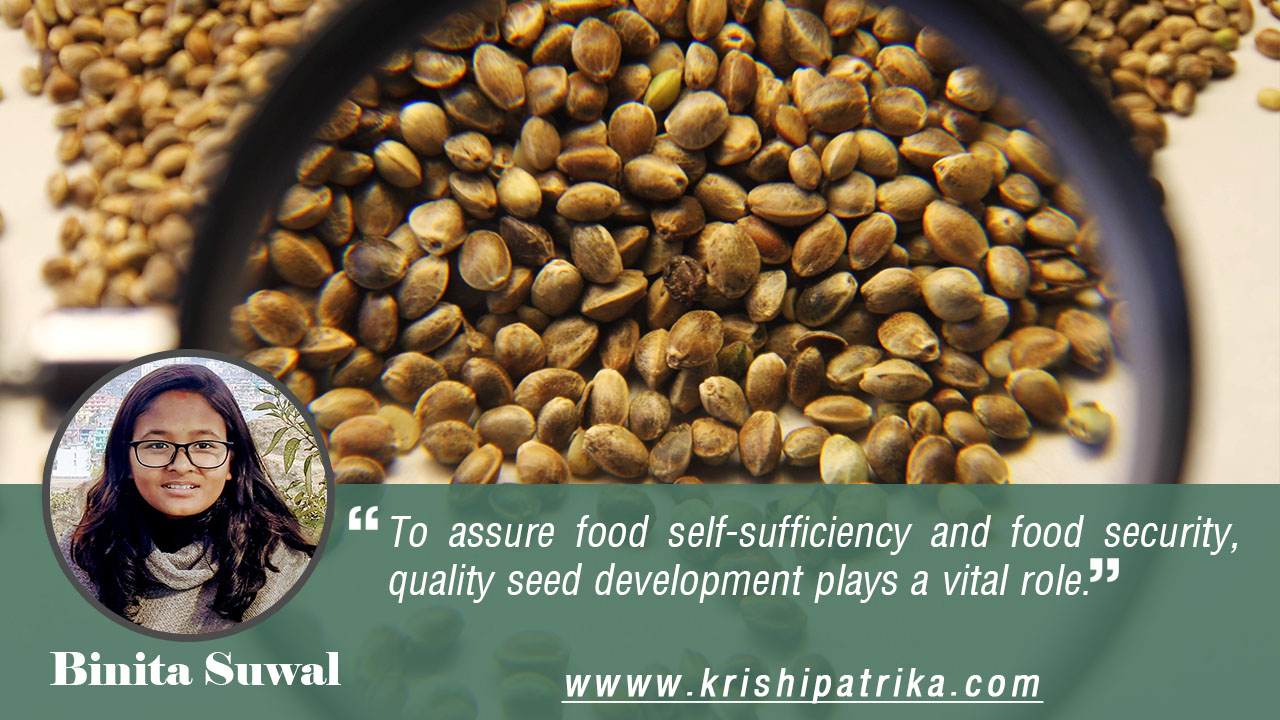
Seed, the key agricultural input, is responsible for developing the resilient agricultural sector and food systems. A country must be seed secure to achieve food security. Seed security can be explained as the availability and accessibility of quality seed at right time and at a reasonable price.
In the current decade, farmers and producers are attracted to hybrid seeds than their local varieties. The reason is, these crops from hybrid seeds mature sooner and give higher yield than local varieties. This has changed Nepal’s state from self-reliant into a dependent country in terms of seeds, plant genetic resources and food. It has been reported that among the released variety of our country, about 73% have foreign ancestors and for wheat, potato, and lentils it is nearly 80%(Chaudhary et al., 2016). Nepal was once (in 90s) a seed exporting country but today it is known as a huge importer in terms of plant genetic resources and seeds. More than 90% of vegetable seeds are imported in Nepal. This high level of dependency may threaten food security in the near future, if our neighbor countries refused to export these materials to Nepal. Hence, to assure food self-sufficiency and food security, quality seed development plays a vital role.
A scientifically produced and superior seed in terms of physical, genetic, physiological, and pathological parameters are said to be of quality. Important aspects of quality seed are trueness to variety(seeds present in bag must be of variety mentioned in the label), presence of weed seed, off type seed or inert matter, germination percentage, vigor, appearance, disease, and pest. It should have great vigor and germination capacity, bold, plump, and must be without mechanical damages and genetic deterioration and meet certification standards.
A huge loss of maize in Bara district (Barren cobs of Maize) was due to illegal entry of unregistered seed and poor-quality seed. Similarly, neck blast and bacterial leaf blight in paddy in Bhaktapur (2013) caused a huge loss in paddy. The destructive tomato pests, Tuta absoluta caused great loss in tomato cultivation (3 years ago). Maize infested with fall armyworm in almost half of the district (2019). And we still don’t have quality seed resistant to fall armyworm. It has the potential to cause maize yield loss of 20-25%. These are some examples of results that occurred due to the use of poor-quality seed. According to Sapkota et al , NARC had released 60 different rice varieties till 2010. But still, the rice production trend remains stagnant for five years and hence, raised a question mark in the improvement of seed quality.
Informal seed production system is quite popular in developing countries i.e. about 80-90% of seed produce by smallholders is produced by this system. Nepalese farmers mostly prefer to use seeds they have saved from the previous growing season and in rainfed condition. The demand for crop variety depends on the popularity of the variety instead of searching for agronomic performance and genetic benefits of variety. Farmers are unaware of available better options with comparatively better benefits and superiority. This informally produced seed whether meets the criteria of certification standards or not, is a mystery for farmers. Further, their germination percentage, purity percentage is unknown. As a result, there is a high risk of producing such crops for seed producers and farmers.
Quality of seed may also degrade during storage. If seed is not stored in an appropriate atmospheric condition, there is a high chance of pest and disease infestation.
A seed lot travels several countries during the activities involved in the seed value chain (Multiplication, production, processing, and packaging). With the increment in many cases of COVID-19 patients, the government has been still creating restrictions on movement and transport intending to protect people from COVID-19. This has seriously affected the production, certification, distribution, and cost of seed in developing and less developed countries like Nepal. With closed border and decrease in import process of food and seed, self-production of the country becomes insufficient to feed 3 crores people of the country. To increase crop productivity, it is impossible to increase the land area for cultivation, and sowing at higher rate than recommendation may result in overcrowding and increase in competition among crops and hence yield decreases. Therefore, a better way to increase seed yield with superior qualities is to use quality seed.
So, how to improve seed quality?
Seed Quality Control Center was established to ensure the availability of locally adaptable good quality seed varieties and play crucial roles in promoting Nepalese seed. Seed quality control is important for every step of the seed value chain. Newly developed best varieties must be advertised, so that farmers would be aware of better options available in the market. Farmer must be aware of the proper storage techniques and recommended amount of seed rate. For this, they should be trained. Seed produced from the informal system should be sent for the process of certification to determine whether the local seed is superior and meets the certification standard and field standards. Illegal entry of plant genetic resource and seed must be checked and the plant quarantine and custom office must be well operated. Proper seed processing and storage techniques must be applied to prevent mechanical damage, inert matter, diseases, and pest. Field inspection by field inspector ensures seed quality to some extent.









